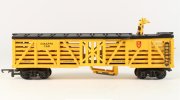Being held up on a recent motorway journey by an outsize load made me wonder how the railways used to handle such traffic. The 1950 General Appendix contains some intriguing details about the conveyance of out-of-gauge loads, including arrangements for obtaining temporary wrong line orders, circumstances in which trains carrying out-of-gauge loads required red headlamps and so on. The signalling instructions include a series of bell codes associated with out-of-gauge traffic involving the closure of adjoining lines, trains able or unable to pass out-of-gauge loads, etc.
Does anyone know about this type of traffic? What typically constituted out-of-gauge loads? How frequently were out-of-gauge loads carried and over what distances? What were the largest out-of-gauge loads which were ever conveyed? To what extent did out-of-gauge traffic considerations impact the design of infrastructure (if at all)? Did common carrier obligations apply or could out-of-gauge traffic be refused?
All information about this much appreciated.
Does anyone know about this type of traffic? What typically constituted out-of-gauge loads? How frequently were out-of-gauge loads carried and over what distances? What were the largest out-of-gauge loads which were ever conveyed? To what extent did out-of-gauge traffic considerations impact the design of infrastructure (if at all)? Did common carrier obligations apply or could out-of-gauge traffic be refused?
All information about this much appreciated.

